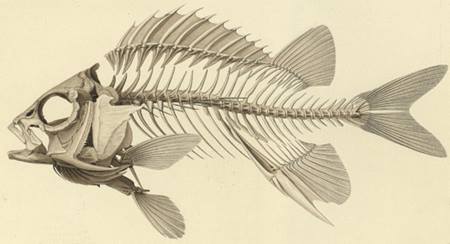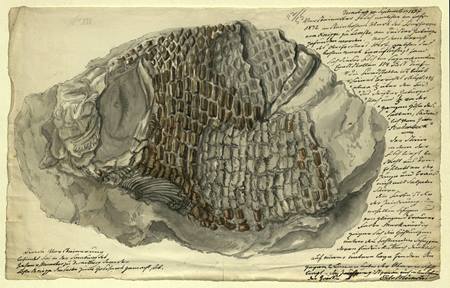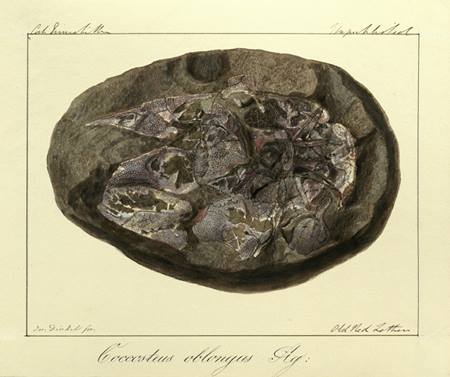
|
| Drawing of Holocentrum Leo by Joseph Dinkel, c.1832-1833, from the Jardin des Plantes, Paris. Archive ref: LDGSL/613/5/2/1 |
Over £11,000 was raised from donations from our Fellows, Friends and other generous individuals, towards the Library’s project to preserve the original artwork for Jean Louis Rudolphe Agassiz’s (1807-1873) publications ‘Recherches sur les Poissons Fossiles’ (1832-1843/4) and its follow up 'Monographie des Poissons Fossiles du Vieux Grès Rouge' (1844/5)
The Geological Society’s collection
The Society had heavily supported Agassiz’s research for these publications which was ostensibly to describe every species of fossil fish he could find. Promoting his project amongst the social and scientific networks of its Fellows gave Agassiz access to specimens and collections to study. Interesting items were sent to the Society’s premises at Somerset House where a room was set aside for his principal artist, the Austrian born Joseph Dinkel (c.1806-1891), to copy the fossils usually in watercolour.
The Society and its Fellows also provided financial support. In 1834, the Society had awarded Agassiz the Wollaston Fund and two years later he was presented with the Wollaston Medal which is still the highest award the Society bestows. Wealthy Society Fellows Lord William Willoughby Cole, (1807-1886), later the Earl of Enniskillen, and Sir Philip de Malpas Egerton, (1806-1881) defrayed some of Agassiz's costs by having specimens from their fossil cabinets drawn by Dinkel at their own expense - the drawings becoming their property once Agassiz had had them copied onto lithographic stones.
 |
This item is from one of the unpublished series and is an example of the kinds of information which was sent to Agassiz as part of his research. The large watercolour and ink study of the head and partial body of the fossil fish Lepidotus was made in September 1836, possibly by the artist G A H Köppel. It is a specimen from the collection of Georg Graf von Münster, Comte de Münster. Archive ref: LDGSL/614/2/55.
|
Despite this, the cost of the research involved in such a major work, combined with the expensive colour printing techniques saw Agassiz having to sell his own natural history collection. With nothing left apart from the original artwork, which was of no further use once converted to lithographic prints, these were next marked to be sold. Egerton originally approached the British Museum on Agassiz's behalf, but apparently meeting with little interest instead persuaded his brother, Lord Francis Leveson-Gower (1800-1857), later 1st Earl of Ellesmere, to purchase most of the drawings and paintings for £500 in 1843 – which were then given to the Society.
In 1858 Agassiz, who had by this time all but given up on fossil fish as a research topic, donated the artwork for 'Monographie des Poissons Fossiles du Vieux Grès Rouge' along with the mainly unpublished remnants from 'Recherches sur les Poissons Fossiles’ to the Society. The drawings from Egerton’s and Enniskillen’s collections were donated separately in 1876 and 1881 respectively to join the rest.

|
This is another example of an unpublished drawing, this time from the collection of William Willoughby Cole, 3rd Earl of Enniskillen. It shows the fossil fish Coccosteus oblongus Agassiz from the Old Red Sandstone, Lethen Bar, Nairnshire in Scotland. The drawing is undated but it is probably among the specimens given to Enniskillen in 1840 by Lady Eliza Gordon-Cumming on whose land they were discovered. Gordon-Cumming sent her own drawings of the fish to Agassiz, but complained later that he used them without her permission. Archive ref: LDGSL/616/2/10/2.
|
How we used your donations
Your donations funded the conservation and digitisation of two thirds of the collection, including the artwork for Agassiz’s five volume publication ‘Recherches sur les Poissons Fossiles’ (published 1833-1844) and two of the unpublished folios.